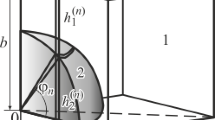Conclusion
We generalized the self-consistent method of effective media to the case of a four-phase model consisting of a core, a shell, a binder, and the effective medium. We obtained analytic solutions for the elastic characteristics, coefficient of linear expansion, heat capacity, and thermal conductivity of a multiphase composite containing several types of composite (or hollow) spherical inclusions. In the special case of a composite containing inclusions of just one type, the solutions obtained for the bulk modulus of elasticity K, coefficient of linear expansion a, heat capacity cσ, and thermal conductivity agree (within the framework of the two-stage approach) with the values found using known solutions for a three-phase model [8]. The first stage entails calculation of the effective characteristics of a spherical composite inclusion, while the second stage involves calculating the analogous characteristics for the composite as a whole.
The possibilities of the solutions that were found were illustrated in a calculation of the shear modulus of a composite containing spherical hollow inclusions. It was shown that by assuming a nonaxisymmetric Weibull distribution of the parameter ψ (the ratio of the thickness of the wall of a particle to its radius) it is possible to reach better agreement between the calculations and the experimental data in [4] than when calculations are performed using only the mean value of ψ.
The solutions obtained here can be used to find optimum combinations of volume fractions of different types of fillers in multiphase composites.
Similar content being viewed by others
References
V. A. Kochetkov, “Effective characteristics of the elastic and thermophysical properties of a unidirectional hybrid composite. Report No. 1.” Mekh. Kompozit. Mater., No. 1, 38–46 (1987).
V. A. Kochetkov, “Effective elastic characteristics and thermophysical properties of a unidirectional hybrid composite. Report No. 2,” —Ibid.,, No. 2, 250–255 (1987).
J. C. Smith, “Correction and extension of van der Poel's method for calculating the shear modulus of a paniculate composite,” J. Res. Nat. Bur. Stand. Sect. A,78A, No. 3, 355–361 (1974).
V. K. Kinra and E. Ker, “Effective elastic moduli of a thin-walled glass microsphere/PMMA composite,” J. Compos. Mater.,16, 117–138 (1982).
L. E. Nielsen, “Elastic modulus of syntatic foams,” J. Polym. Sci. Polym. Phys. Ed.,21, No. 8, 1567–1568 (1983).
V. A. Kochetkov, “Use of the effective medium method to calculate the elastic characteristics and creep functions of a sphere-reinforced plastic,” Mekh. Kompozit. Mater., No. 2, 177–188 (1994).
T. D. Shermergor, Theory of Elasticity of Microheterogeneous Media [in Russian], Nauka, Moscow (1977).
R. M. Christensen, Mechanics of Composite Materials, Wiley-Interscience, N.Y. (1979).
Author information
Authors and Affiliations
Additional information
The work was sponsored at the University Iberoamericana in 1994 by the Mexican National Council of Science and Technology (CONACYT).
Translated from Mekhanika Kompozitnykh Materialov, Vol. 30, No. 4, pp. 512–519, July–August, 1994.
Rights and permissions
About this article
Cite this article
Kochetkov, V.A. Calculation of characteristics of the elastic and thermophysical properties of a multiphase composite containing composite or hollow spherical inclusions. Mechanics of Composite Materials 30, 371–377 (1995). https://doi.org/10.1007/BF00634761
Received:
Issue Date:
DOI: https://doi.org/10.1007/BF00634761



